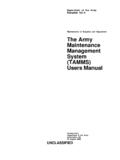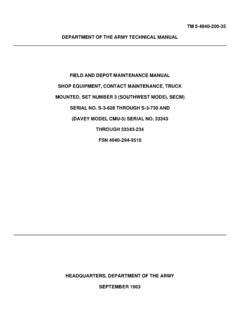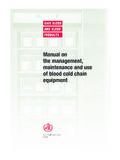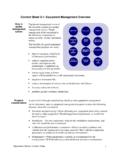Transcription of Autonomous Maintenance - WSSHE
1 Autonomous MaintenanceTPM & Autonomous MaintenanceI run it,you fix it !I fix it,you run it !What is Maintenance ?Why is Possible Utilization Rate Necessary?One way to look at Lean (JIT) production is to compare it to the body s circulatory system, in which blood flows to the various organs just-in-time to be used. Just as the factory (hospital) handles large and small parts for its products , so too does the body have its large arteries and small veins and Lean (JIT) production, however, any delay in the flow of small parts (in the veins of processing sub-line) soon stops the flow of the large parts (in the arteries or main production line).To prevent such problems, Lean (JIT) production vitally depends on maintaining a condition of zero breakdowns. This makes proper Maintenance an essential part of (JIT) production. That is why it is more important to maximize the equipments possible utilization rate (the availability of functioning equipment ) than to raise its capacity utilization rate.
2 People need to know the equipment will be in working order whenever they need key to achieving zero breakdowns is not Maintenance in terms of repairing broken down equipment , but rather preventative Maintenance that treats the causes of breakdowns before the breakdowns actually Hirano4 Types of Maintenance Preventative Maintenance :routine Maintenance to maintain the basic equipment conditions, replace deteriorating parts, and maintain equipment in on-spec condition. It is carried out at predetermined periods, to ensure equipment reliability. Predictive Maintenance (condition-based): corrects equipment deterioration by condition monitoring and machine diagnosis and helps detect impending problems before they occur. Breakdown Maintenance (reactive): corrects equipment deterioration afterthe occurrence of a breakdown. Autonomous Maintenance :Process by which equipment operators accept and share responsibility (with Maintenance ) for the performance and health of equipment4 Types of MaintenanceThe Six Big Losses of Machine and equipment AvailabilityPlanned AvailabilityEquipmentFailureSetup & AdjustmentEquipmentFailureSetup & AdjustmentEquipmentFailureMinor StoppagesSetup & AdjustmentEquipmentFailureMinor StoppagesSpeed ReductionsSetup & AdjustmentEquipmentFailureMinor StoppagesSpeed ReductionsUnusable OutputSetup & AdjustmentEquipmentFailureMinor StoppagesSpeed Reductions Unusable ConditionUnusable OutputReduced YieldDowntime LossesSpeed LossesQuality LossesUsage LossesThe Real Losses of Machine & equipment Non-AvailabilityWe must make up these means.
3 Overtime$(lost weekends)Running Bigger/ Larger Batches$It means buying bigger, faster, more expensive equipment so we can run faster after we fix it!$$$$ContinuousImprovementContinuousIm provementDetecting And Responding To Abnormal ConditionsDetecting equipment FailuresDetecting Conditions that lead toequipment failuresProduction StoppagesExcessive wearLeaksDust, Dirt, GrimeCorrosionOver-HeatingVibrationDefor mationMisalignmentLack of lubricationQuality ProblemsReactingRespondingPreventingCond itions that lead toequipment failuresPreventionMACHINE NOT 100%.KEEP MACHINE AT 100%.FIX on the Path to equipment Breakdown Stage 1: Latent minor defectsThough difficult to see or hear, the machine s rotating and moving parts are operating under increasing friction and its fastened parts are getting a little looser. These and other subtle defects characterize the first stage of equipment deterioration Stage 2: Apparent minor defectsThe same defects described in the first stage have now become somewhat noticeable to the eye or ear.
4 In addition, the machine may be vibrating more, making more noise, and leaking small amounts of oil, water, or air. But none of these defects are major enough to impair the machine s functioning. Stage 3: Performs below expectationsAt this stage, it has become difficult to get the machine to perform with the desired precision and within the specified tolerances. The machine is turning out products with varying quality or not performing as specified, and suddenly it needs more adjusting than it use to require. It can no longer keep up with quality standards and is producing lower yields or performance on the Path to equipment Breakdown Stage 4: Stops IntermittentlyAt this stage, the machine has to be shut off fairly often to make adjustments to bring the functioning and product quality back into line. The machine frequently turns out sub par results, but can be usually started up again after making simple adjustments and repairs.
5 Stage 5: Stops or Breaks DownAt this final stage, the machine functions so poorly that it stops itself, which is to say it breaks should keep in mind that machines usually break down due to deterioration, and these kinds of breakdowns never happen all the sudden; they happen in stages. One or more machine s deteriorating parts are left to deteriorate and eventually this deterioration accumulates or combines in a simple or complicated way to cause a we respond to deterioration only when it reaches the fifth stage, we will have to deal with various machines that are currently at the other four stages in the path. In other words, we cannot hope for a true reduction in breakdowns until we work our way up the path and treat deterioration before it results in and Safety Stages1 Machines breakdown frequently. Accidents are common2 Fixing machine breakdowns is always left to Maintenance staff.
6 Accidents occur occasionally3 Thorough Maintenance and repairs are done after breakdowns occur. Major accidents rarely preventative Maintenance is practiced. Major or minor accidents rarely Maintenance activities are practiced. No machine breakdowns or accidents is TPMFive Main innovative approach to Maintenance that optimizes equipment effectiveness through continuous improvement of product and service a world class reliability based Maintenance system utilizing proactive, predictive, and preventative Maintenance practices focusing on the entire equipment life buy in at every level of the organization. Executive to middle management to frontline teams working all departments and requires the participation of vendors, (engineers) operators, and Maintenance and implements team-based activities aimed at the organization-wide goal of zero defects and zero TPM perform Maintenance functions for which they have been trained, that do not require skilled Maintenance Maintenance persons train equipment operators in equipment Maintenance personnel move from the fire-fighting mode to the prevention Benefits Sharpens the employees equipment related knowledge and skills.
7 Improves internal communications. Provides a basis for training and team unity Establishes an equipment base line. Allows easy audit and diagnosis. Controls process and equipment do you need a TPM Program? To make effective use of your human resources To eliminate unscheduled downtime To met quality and regulatory certification requirements To increase equipment efficiency To avoid reactive crisis managementThe Role of Maintenance in TPM Provide technical support and training for Autonomous Maintenance done by operators Restore equipment to like new condition Identify design weaknesses and improve equipment to error-free function Improve the technical skills of all Maintenance team members through training, teamwork, and work assignmentsThe Role of Maintenance in TPM (continued) Implement a reliability based Maintenance system established upon data from equipment manufacturers and equipment operators Through the use of data analysis, predictive Maintenance , and diagnostic non-intrusive tests, perform appropriate Maintenance to avoid equipment failureThe Role of Maintenance in TPM (continued) Maintain a work order system and equipment data base to monitor and support continuous equipment improvement Ensure that Maintenance is treating root cause and not the symptom Understand the product and service process and be able to operate the equipment to successfully achieve the above goalsWhat is Autonomous Operator Maintenance ?
8 Autonomous Maintenance is a phrase coined to clarify the shift to operators participating in maintaining their own equipmentAM area based-Operator Conducted-Operator Enhancing-Team Activity-TPM Foundation-Part of the Job There are seven fundamental steps to Autonomous maintenanceThe Seven Steps of Autonomous Maintenance Step 1: Clean and inspect Step 2: Eliminate cause of machine stoppage and inaccessible areas Step 3: Establish cleaning and lubrication standards Step 4: Conduct general inspections, verify standard operating conditions Step 5: Conduct Autonomous inspections after operators are trained on equipment function and parameters for good operationThe Seven Steps of Autonomous Maintenance Step 6: Standardize and visually manage all work processes, lubrication, inspection, and cleaning standards, data records, spare parts and tool management.
9 Step 7: Implement Autonomous equipment management, develop company policies and objectives, keep reliable data and improve equipment Measure Results:Zero BreakdownsZero DefectsZero Lost Time AccidentsAutonomous Maintenance Workshops8 Steps of Implementation Step 1: Establish workshop baseline Step 2: Energy Awareness Step 3: Cleaning is Inspecting Step 4: Eliminating Contamination Step 5: Visual Management Step 6: equipment / Tool Maintenance Step 7: equipment Lubrication Step 8: ConsumablesThe Spirit of Autonomous Maintenance Discard old attitudes Think of ways to make new ideas work don t say we can t , before you even try, don t accept excuses Don t substitute money for brains Correct problems immediately Ask why five times to get to the root cause Improvement is made at the workplace, not in the office Ideas from many people are better especially if the people are closer to the problem There are no limits to improvementWorkshop Leader: equipment Description:StartTargetDay1 Day2 Day3 Day4 Visual Controls IdentifiedTags WrittenTags CompletedCritical Cleaning Points Idendtified / DocumentedInspection Points Identified / DocumentedLube Points Identified / DocumentedNumber of Contamination Sources Identified (ex: oil leak, etc.)
10 Routes and Processes Dcoumented5S LevelSinglePoint LessonsNumber of Revisions to the PMCCI&L = Critical Cleaning is Inspecting & LubricatingDate:Work Area: Autonomous Maintenance Progress ReportStart Up/Shut Down Lockout /Tag/TryoutConsumable Restocking Plan CCI&L StepProcess NameActivities1 Clean and InspectEliminate all dirt and grime on the machine, lubricate, tighten bolts, and find and correct problems2 Eliminate problem sources and inaccessible areasCorrect sources of dirt and grime; prevent spattering and improve accessibility for cleaning and lubrication. Shorten the time it takes to clean and up cleaning and lubrication standardsWrite standards that will ensure that cleaning, lubricating, and tightening can be done efficiently. (Make a schedule for periodic tasks)4 Conduct General InspectionsConduct skills training with inspection manuals and use general inspections to find and correct slight abnormalities in the Autonomous inspectionsPrepare standard checksheets for Autonomous inspections.






